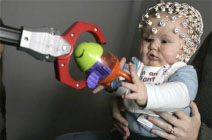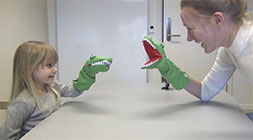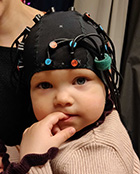Our research methods
We use various different methods in our lab, and below you can learn more about each of these. Some of our studies use behavioural methods where we play a game with the child (like the study with the crocodile puppets). In other studies, especially with younger babies who cannot do many actions themselves, we try to learn about their knowledge through our baby-friendly eye-tracking and brain imaging methods. These methods are all suitable for small infants, who move around a lot. In our studies involving brain imaging, we are measuring naturally occurring brain activation in response to pictures or small animations that we show to the baby. Our methods cannot interfere with the baby’s brain activity, they simply measure what is already occurring. If you take part in a brain imaging study, we will give you a photo of your baby wearing our hats, so that you have a souvenir of your visit.
Behavioural studiesBehavioural studies are studies where we play small games with the child. To the children these are just fun games, but their behaviour reveals very useful insights into how young children think, before they can tell us with their own words. |
|
|
|
Eye trackingEye tracking has been used for many years as a method to examine attention and perception in babies and children. The method allows us to know what children pay attention to when we show them events on a screen. |
Functional Near-Infrared Spectroscopy (fNIRS)fNIRS allows us to measure which areas of a child's brain are involved in a particular task by providing a measure of changes in the amount of oxygen in the blood. |
|
 |
Electroencephalography (EEG)With EEG we measure electrical activity in the brain. The method enables us to learn how a baby's brain responds to different kinds of events and how this brain activity changes over time. |


